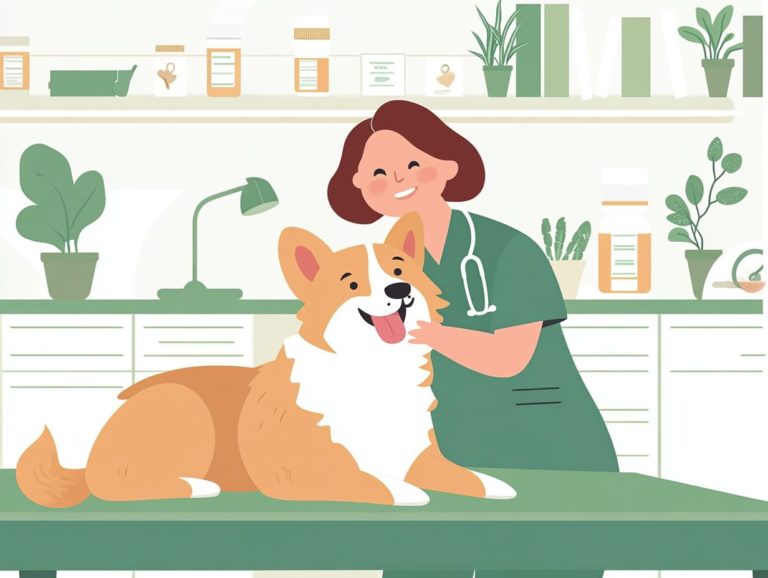Is Anxiety in Pets a Behavioral Issue?
Anxiety in pets, particularly dog anxiety, is a growing concern for many pet owners. It affects the happiness and health of their cherished companions.
Understanding the underlying causes and triggers of anxiety is crucial for recognizing its signs and symptoms effectively. This article delves into various approaches for treating anxiety, from training methods to medication.
It also looks at the connection between anxiety disorders and behavioral challenges. By doing so, it guides you in creating a calmer and more relaxed environment for your beloved animals.
Contents
Key Takeaways:

Here are some important points to keep in mind about pet anxiety!
Understanding Anxiety in Pets
Is your furry friend acting differently lately? Understanding anxiety triggers in pets, especially in dogs, is crucial for those who wish to prioritize the emotional well-being of their companions.
Dog anxiety can take many forms, such as separation anxiety (when a dog gets very stressed when left alone) and fear-related issues. These often result in distressing symptoms like excessive barking, hiding, or destructive behaviors.
By recognizing these signs early, you can take proactive steps to implement effective treatment strategies. Consulting reputable resources, such as the AKC and the Merck Veterinary Manual, will provide valuable insights into common causes and solutions to help your furry friend feel more secure and at ease.
Causes and Triggers
Understanding the causes and triggers of anxiety in pets is essential for effective management. These factors can differ significantly among various dog breeds and individual dogs.
Many dogs become particularly anxious during thunderstorms or fireworks. The sudden eruption of loud noises sparks fear, leading them to hide or bark incessantly.
Situations such as being left alone, changes in routine, or the introduction of new pets can further contribute to their distress. By recognizing these specific anxiety-inducing scenarios, you can make meaningful adjustments in your dog’s environment.
Establishing predictable routines can work wonders. Consistent schedules for feeding, walking, and playtime instill a sense of security and help ease their emotional responses during stressful moments.
Identifying Anxiety in Pets
Identifying anxiety in pets requires a discerning eye and a deep understanding of their body language. By observing the subtle symptoms of anxiety, you can accurately gauge your dog’s emotional response to various stimuli. For more insights, check out what you should know about anxiety in senior pets.
Signs and Symptoms

The signs and symptoms of anxiety in dogs can reveal themselves through a variety of physical behaviors and emotional responses.
You might notice your dog pacing back and forth with anxious energy, persistent whining conveying distress, or retreating to hidden corners as a means of self-protection.
These behaviors are significant indicators of unease and can escalate into more serious behavioral issues if not addressed.
A dog that paces continuously may develop compulsive behaviors, while one that hides could become socially withdrawn or show aggression towards perceived threats.
Recognizing these signs is essential for you as a pet owner. By identifying anxiety in your dog, you can implement effective training strategies designed to alleviate their fears.
Treating Anxiety in Pets
Addressing anxiety in your pets often requires a multi-faceted approach. This involves exploring various anxiety treatment options and seeking the expertise of veterinary behaviorists to develop a comprehensive treatment plan tailored to your pet’s unique needs, including understanding whether pet anxiety is genetic.
Don’t wait! Learn how to help your pet feel better today!
Behavioral Therapy and Medications
Behavioral therapy and medications help manage pet anxiety, and it’s important to consider whether medication is necessary for pet anxiety to enhance their emotional well-being and alleviate anxiety symptoms.
Incorporating techniques like desensitization which means slowly getting your pet used to things that make them anxious and positive reinforcement, which rewards calm behavior, can create a comprehensive strategy that comforts your furry companion. This is especially important for older dogs dealing with cognitive dysfunction, as they often experience increased anxiety from confusion and stress.
The combination of therapy and medication offers a balanced approach to soothe anxiety. This not only makes your pet happier but also transforms your home into a peaceful haven!
Preventing Anxiety in Pets
Preventing anxiety in pets starts with a proactive approach that integrates tailored strategies suited to each dog’s unique needs and lifestyle. By understanding these individual factors, you can create a calmer, more secure environment for your furry friend.
Tips for Reducing Anxiety Triggers

Implementing strategies to reduce anxiety triggers can significantly enhance your dog’s emotional well-being by minimizing exposure to stress-inducing events.
Start by identifying specific triggers, such as loud noises or unfamiliar places. Gradually desensitize your pet to these stimuli through controlled exposure. Creating a soothing atmosphere at home can further support this process. Consider using soft music, calming scents like lavender, and cozy spaces where your dog can retreat to feel safe.
Incorporating positive reinforcement training techniques when your dog remains calm can boost their confidence. This helps them navigate potentially stressful situations with greater ease. Over time, these methods will not only improve your dog’s behavior but also deepen the bond you share.
The Relationship Between Behavioral Issues and Anxiety
The relationship between behavioral issues and anxiety in pets is intricate. Understanding anxious behaviors in pets is crucial, as anxiety disorders can frequently intensify or even cause a range of behavioral problems in dogs.
How Anxiety Can Lead to Behavioral Problems
Anxiety can significantly impact your dog’s behavior, affecting their fear responses and emotional reactions in various situations. For more insight, explore pet anxiety and its connection to behavior problems, as this can create a distressing cycle.
If left untreated, anxiety can escalate into severe challenges, including aggression or destructive behaviors. The resulting heightened stress levels not only affect your dog s well-being but can also disturb the harmony of your home.
Act now to create a tailored treatment plan for your dog’s needs! This may involve behavioral therapy, gradual desensitization, and the introduction of calming techniques.
With the right framework in place, you can break the cycle of anxiety and cultivate a more balanced and harmonious lifestyle for both you and your furry companion.
Frequently Asked Questions
Is Anxiety in Pets a Behavioral Issue?

Yes, anxiety in pets can be considered a behavioral issue as it affects their behavior and interactions with their environment. It often manifests through physical actions and emotional responses.
What are some common signs of anxiety in pets?
Common signs of anxiety in pets include excessive barking or meowing, destructive behavior, excessive grooming, and loss of appetite. To learn more about these symptoms, check out understanding the anxiety spectrum in pets.
Can anxiety in pets be caused by certain situations or environments?
Yes, anxiety in pets can be triggered by certain situations or environments, such as loud noises, unfamiliar people or animals, or changes in routine. Understanding whether pet anxiety is becoming more common can help owners address these challenges effectively.
Are certain breeds more prone to anxiety in pets?
Yes, some dog breeds are more prone to anxiety. Herding breeds like Border Collies and German Shepherds often show higher anxiety levels, as do those with a history of separation anxiety.
What can I do to help my pet with anxiety?
You can help your pet with anxiety in a few ways. Create a safe environment, provide regular exercise, and consult a veterinarian or animal behaviorist if necessary.
Is medication necessary for treating anxiety in pets?
For severe anxiety cases, medication may be necessary. Options like fluoxetine and clomipramine can help, but they should always accompany training techniques to change how your pet behaves.






